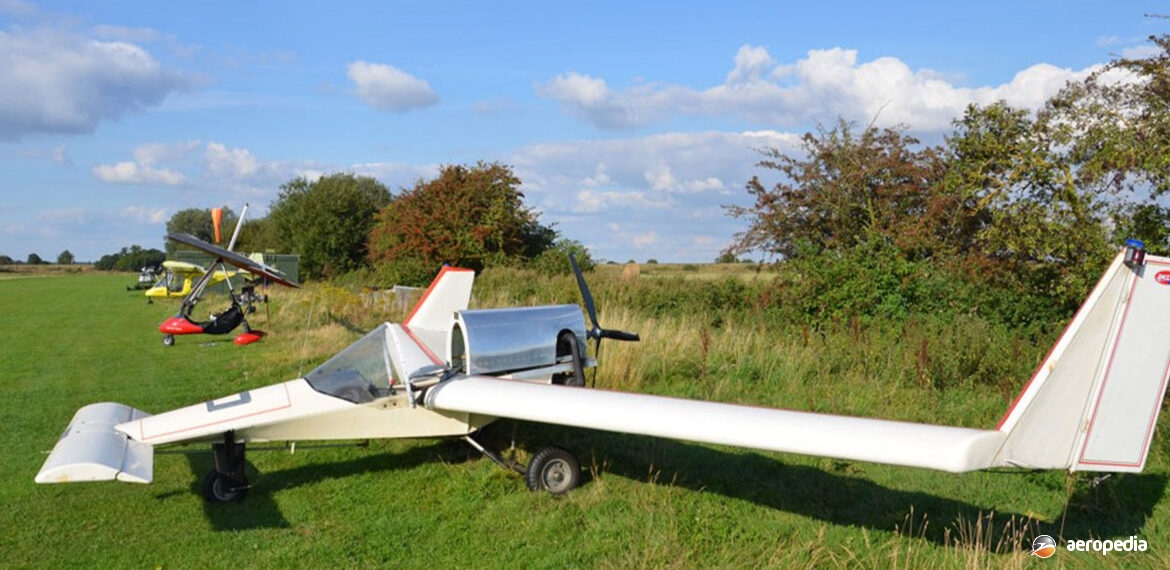Photograph:
A Goldwing Ltd Goldwing (Author’s collection)
Country of origin:
United States of America
Description:
Single-seat ultralight canard-wing sport aircraft
Power Plant:
One 22 kw (30 hp) Kawasaki 440 two-cylinder, two-stroke, air-cooled engine
Specifications:
- [Goldwing UL]
- Wingspan: 9.1 m (30 ft)
- Length: 3.65 m (12 ft)
- Wing area: 11.89 m² (128 sq ft)
- Never exceed speed: 113 km/h (70 mph)
- Cruising speed: 97 km/h (60 mph)
- Stalling speed: 40 km/h (22 mph)
- Take-off roll: 46 m (150 ft)
- Landing roll: 61 m (200 ft)
- Service ceiling: 3,048 m (10,000 ft)
- Rate of climb: 183 m/min (600 ft/min)
- Range: 161 km (100 miles)
- Max glide ratio: 16:1
- Fuel capacity: 11 litres (2.5 Imp gals)
- Empty weight: 132 kg (290 lb)
- Loaded weight: 245 kg (540 lb)
History:
The Goldwing was a single-seat, single-engined, mid-wing aircraft with conventional three-axis control introduced to the ultralight market in 1979, designed by Craig Catto and Brian Glenn, and marketed by Goldwing Ltd in the United States. It was introduced to meet US FAR 103 Ultralight Vehicle Regulations and was produced in a number of variantss and under a number of names, including the Catto Goldwing, the Eurowing Goldwing, and the Goldwing Goldwing. It had swept-back leading and trailing-edges and was of canard design. It was supplied as a complete factory-built aircraft and was not offered in kit form.
The aircraft had its pitch control by elevator on the canard; the yaw control by the tip rudders; and the roll control by half-span up-only ailerons and spoilers. Control was via a stick for pitch and roll and pedals for yaw. The undercarriage was of tricycle configuration, there being no suspension on the nosewheel. It was built of fibreglass and the main wheels had no brakes.
The fuselage was of aluminium tube with fibreglass epoxy composite covering, including Kevlar, carbon fibre reinforced polymer and high density foam. The wing was built of carbon epoxy spar, the remainder of the wing being built of foam and covered with aircraft fabric. The pilot was enclosed in an aerodynamic nacelle. The engine was a Kawasaki 440 two-cylinder in-line, two-stroke, engine designed for snowmobiles, converted for aviation use, and produced by Kawasaki Heavy Industries up until about 1980.
Other engines available included the 22 kw (30 hp) Cuyuna 430R and the 21 kw (28 hp) Rotax 277. Early problems with the aircraft related to a suitable engine and eventually the Fuji Robin of 330 cc was installed in the British-built variant produced by Eurowing. With this engine it satisfied British microlight regulations. However, the Robin was considered to be a little heavy and later the KFM 107 and Koenig SC430 engines were offered, these engines being lighter than the Robin, reducing weight problems with the type.
Two main variants were offered, the Goldwing ST, the initial production aircraft which was found to be too heavy and was too fast to meet FAR 103 limits; and the Goldwing UL, a lightened variant which met Regulations.
Production of the series continued for some years, leading to the Goldwing II fitted with a 37 kw (50 hp) Rotax 503 engine; and the Goldwing Gold Duster fitted with a 26 kw (35 hp) Cuyuna 430 engine.
A few examples are known to have been imported to Australia, one being built by Mr Stanley Onaindia in north Queensland, which was still airworthy in 2000 and reported to have been fitted with two Zenoah engines.

